We hope you’re as excited as we are for Day 2 of CamundaCon 2025 Amsterdam, which kicks off soon! After an exciting day 1, day 2 of the conference has arrived. Stay with this post for the the latest updates from the event live as they’re happening. Be sure to check back frequently as we’ll be updating this post throughout the day.
If you couldn’t join in person in Amsterdam, many sessions are streaming live and it’s free to join online—so you can still catch the action! Just register at the link below, check out the agenda and make sure you don’t miss anything (be sure to filter by livestream). We’ll see you there, whether online or in person!
Update: CamundaCon 2025 Amsterdam has ended, but you can check out the videos (when available) so you don’t miss a thing!
What’s happening right now? The morning run with Bernd and the Camunda team, followed by the unconference, platform mastery series, industry round tables and more. This post will be updated again closer to when the livestream kicks off with the opening keynote with Camunda co-founder and Chief Technologist Bernd Ruecker and Bastian Körber, VP Product Management at 12:30pm CEST / 6:30am ET. See you all then!
We’re back! Once again, congratulations to everyone who took off early today for the morning run. Well done! Including our tall friend all the way on the side there, they look like a great runner to me.
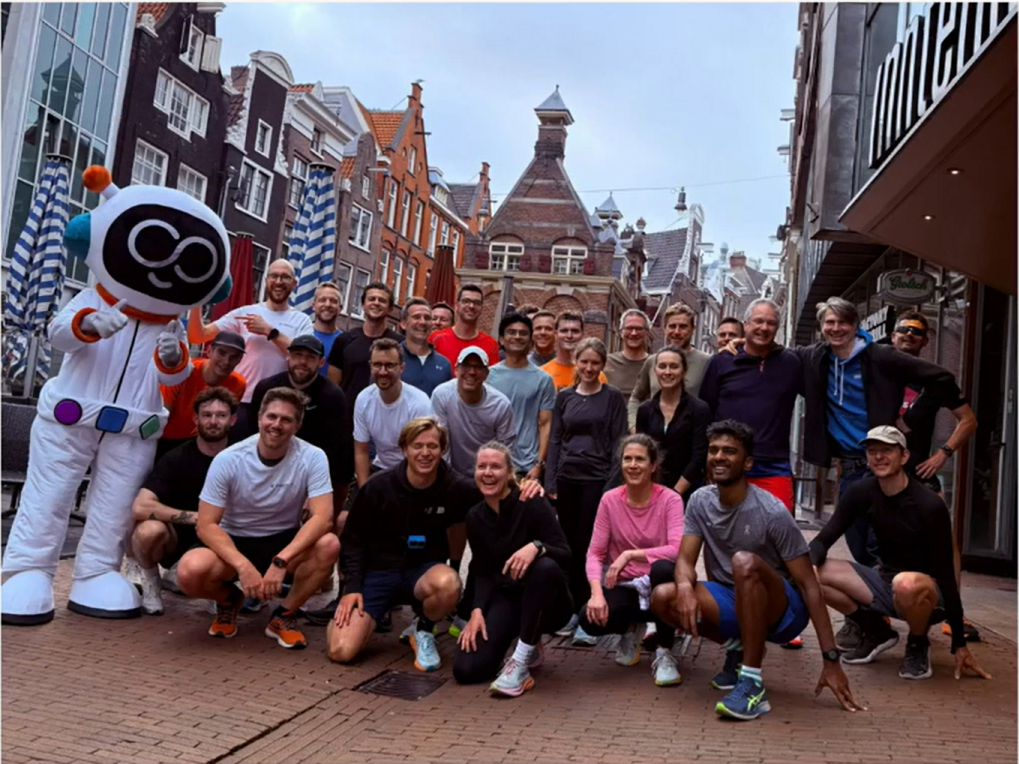
Welcome!
Camunda’s Amy Johnston returned to the stage to welcome everyone to the second day of CamundaCon 2025 Amsterdam! Once again, Amy explained the traditional Camunda Selfie Screen (the first day’s selfies are already up and on display, tag your selfies with #camundacon and #selfie to join!), the Camunda and sponsor booths, available silent disco-style demo business break presentations (listen with headphones as you grab a coffee), and of course how to access the WiFi and Slido for questions. Amy also covered our code of conduct and how you can fill out your “passport” with stickers to help us decide where charitable contributions we’ll be making will go.
Next up, she welcomed Camunda Co-founder and Chief Technologist Bernd Ruecker and Bastian Körber, Camunda’s VP of Product Management, to the stage for today’s opening keynote.
Day 2 Opening Keynote by Bernd Ruecker and Bastian Körber
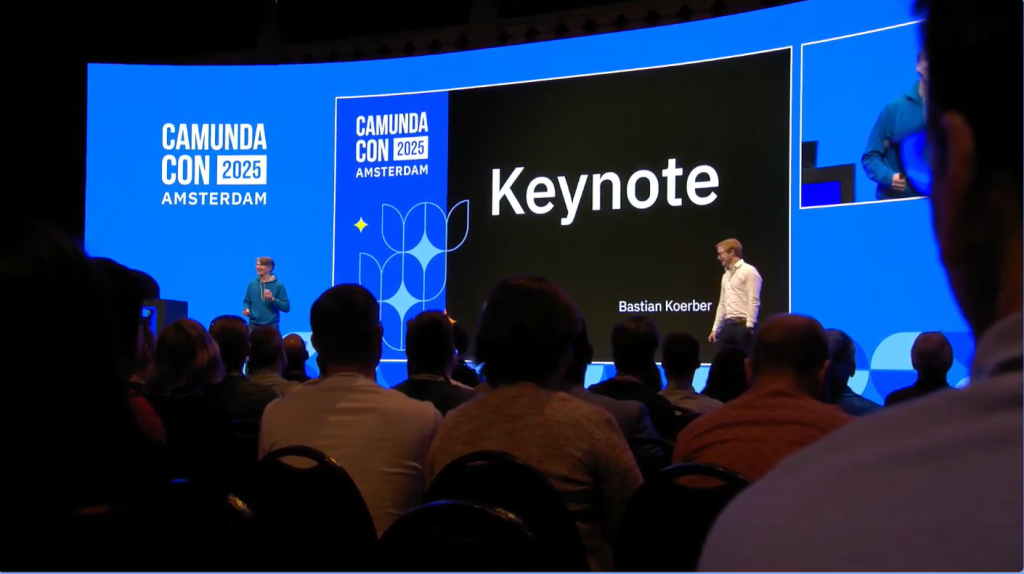
Bernd and Bastian took the stage and without further adieu, Bernd declared: “theory is gray, let’s get to a live demo.” Camunda CTO Daniel Meyer had introduced the concept on stage yesterday of an AI Agent that can assist with loan generation, including by sending the user emails and much more. It’s time to see it in action.
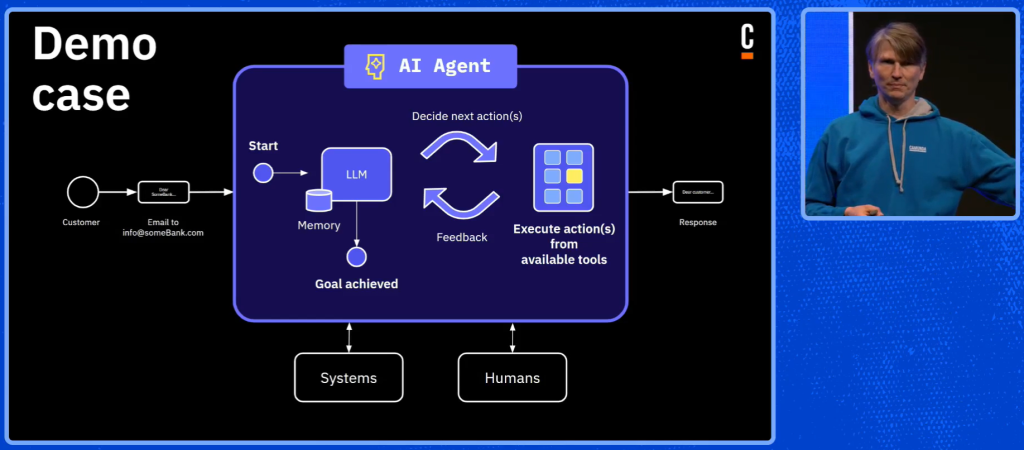
Bernd and Bastian began by making a request for an appointment and demonstrated how the bot replied, including with a specific request to request three timeslots for an appointment—which only required a very simple natural language request in the element documentation in your BPMN.
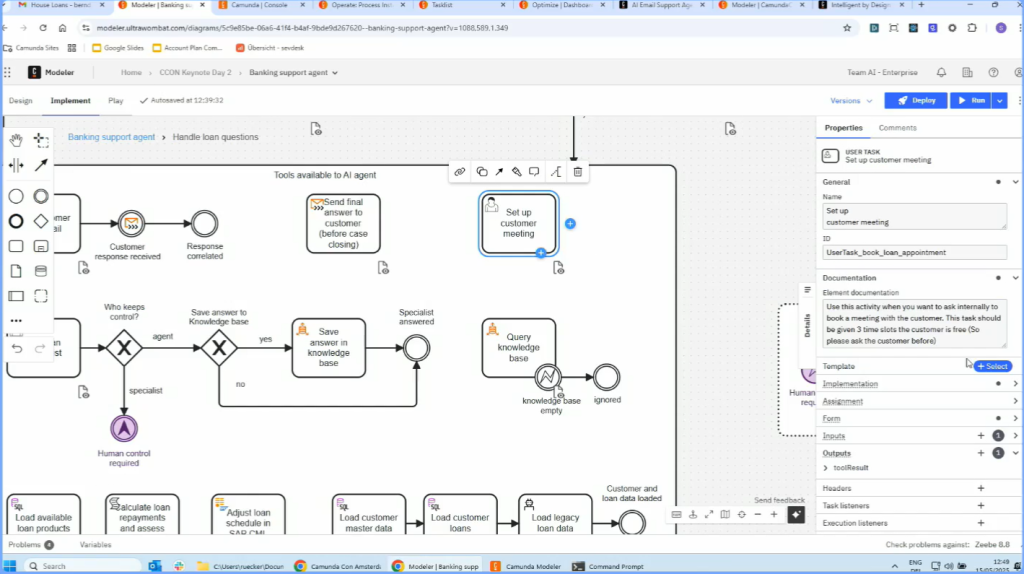
For particularly tricky cases, of course, the AI Agent will consult a human expert. However, the AI Agent is self-learning, which means after you tell it how to handle a given situation, it will learn from that experience and eventually no longer need to ask an expert about it. Bastian noted that this actually makes a live demo a bit tricky, because if you test out the demo environment to make sure it’s working, well, you can’t ask that question again live! Fortunately, Bernd was able to give the Agent a tricky situation about an unfortunate conference speaker who just lost his job.
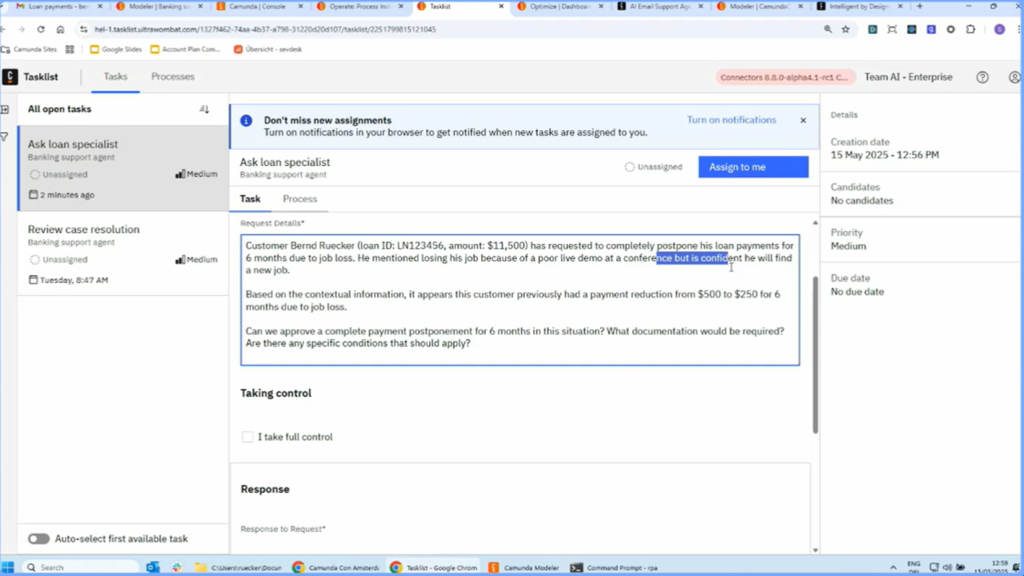
Bernd then noted that this had only been a live demo so far, what about livehacking? So he added a task to greet CamundaCon with every response going forward. As part of this demo, they also displayed Camunda’s new RPA capabilities in action, showcased how Optimize can be used to help you understand your process and understand costs, and much more. If you couldn’t see it live, don’t miss the recording to see all of this working live on stage.
Zooming out a bit, Bastian then talked about the power of Camunda’s ad-hoc sub-process, explaining why Camunda believes AI Agents thrive within BPMN and function better that way than as purely standalone agents (which is how many organizations are implementing AI). He explained that there are four primary capabilities that the Camunda Agent has—the LLM of course, but also memory, tool access, and critical guardrails.
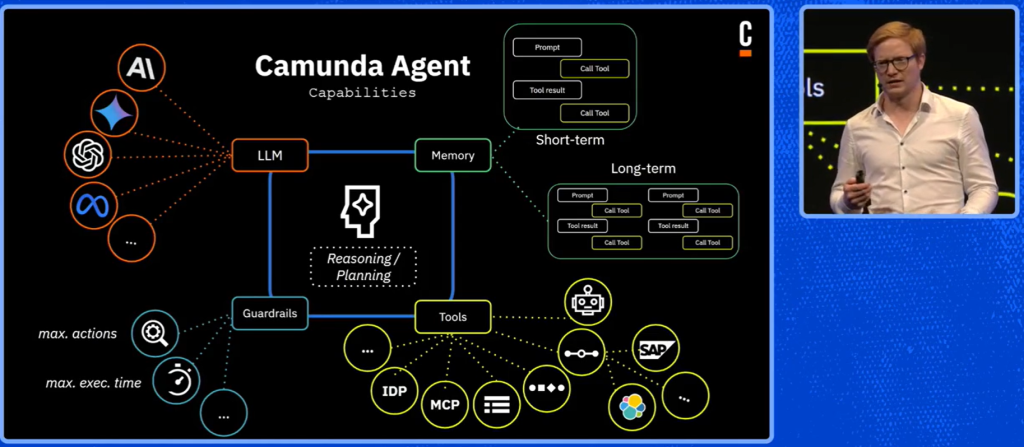
Bernd highlighted the flexibility of Camunda’s approach. Not only can you adopt many different patterns, including multi-agent orchestration (a tool can be an agent itself, and parent agents can coordinate globally while sub-agents plan locally), but you also have the ability to customize as much or as little as you want based on the needs and skills that are in play. Pro-code, no-code, and everything in between—you choose. This is the multi-layer coding experience.
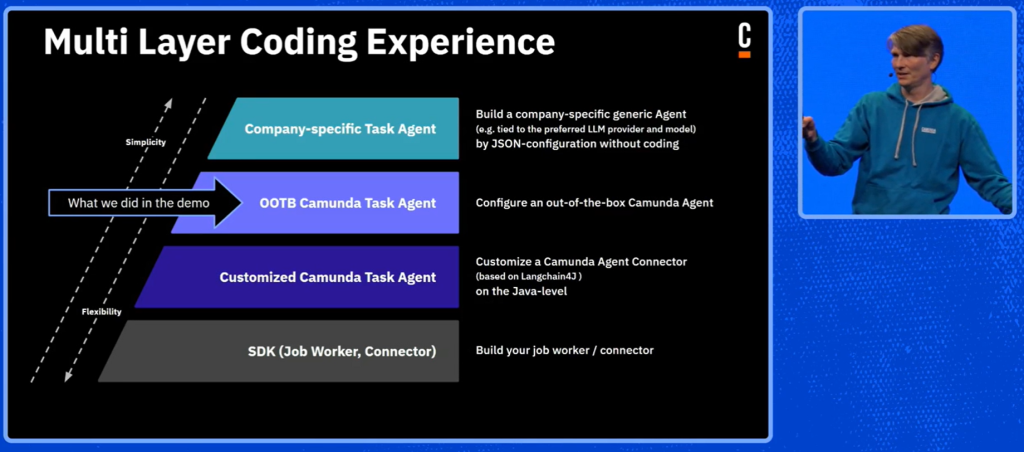
When it comes to Camunda’s approach to AI Agents, Bastian noted that Camunda generally advises to “use workflows when possible, and agents only when necessary.” He also explained the benefits of creating the “deterministic sandwich,” where you have specific flows before and after the agents operate, so you can best control and understand their actions.
Bastian and Bernd closed by highlighting the upcoming Camunda 8.8 release, which includes features like the FEEL copilot, greatly simplified installation and much more. They also displayed the email AI Agent blueprint that is available today and runs on the latest Camunda alpha that was released two days ago—so you can play around with it today.
There was a lot to take in from this keynote, so be sure to check out the whole recording to dig deeper when the videos are shared soon! And don’t forget to check out a new book Bernd co-authored recently, Enterprise Process Orchestration (attendees can grab a copy on site).
Guest Keynote: Four Lenses to Make Process Orchestration and AI Work
Bernhard Schaffrik, Principal Analyst at Forrester was invited to the stage next to give his perspective on how AI is being used today. He led off with a glimpse of a utopian future of what AI can do—where we’re all sitting around sipping drinks while the AI does all the work—but we’re not getting there anytime soon. In the meantime, companies have been experimenting boldly with AI in 2024, noting that he had just about no conversations with business leaders that did not touch on it. This experimentation will only continue.
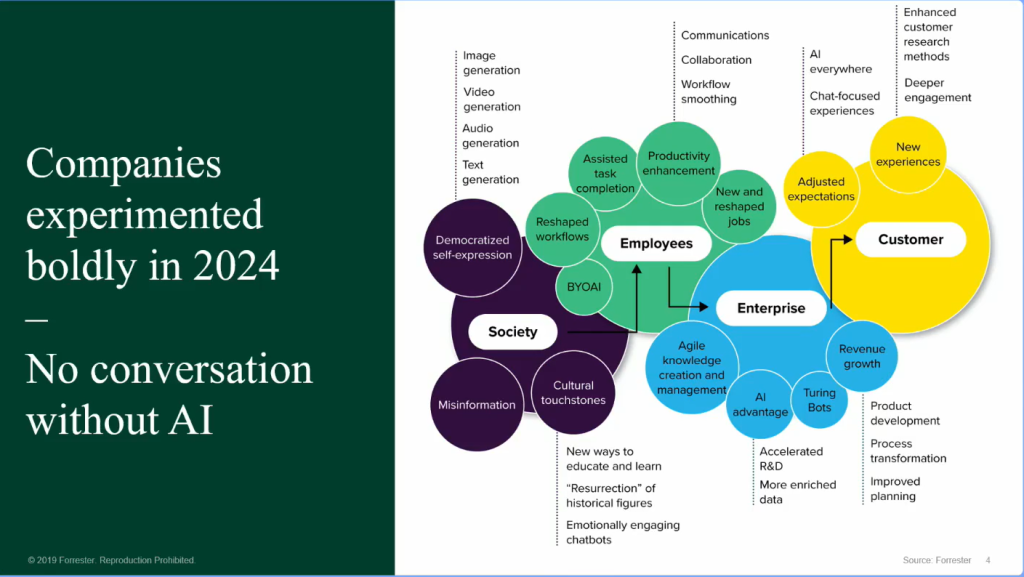
Schaffrik shared a prediction that in 2025 25% of automation projects will combine cognitive and physical automation—or in other words, robots. He gave an example of supermarket upstocking, which now is largely manual, but which can be further automated with the use of a robot. Generative AI will help robotics move past high-volume, low-skill operations and into more complex interactions since they are better at understanding ambiguity.
Another prediction was that in 2025, only 1% of core processes will run on generative AI. Why? There is still too large of a trust gap. That means deterministic orchestration will still be in charge through this year and that the world where generative AI makes these critical unstructured decisions will have to wait. Schaffrik also identified siloed work as a damper on efficiency, and noted that process orchestration is a fantastic way to break these down.
So how do we get to the future where we are maximixing Agentic AI? There are four lenses that Schaffrik wanted to share to help us understand this question.

Thinking about the value of an AI more than just the cost—treating your AI agents like new hires that you have to onboard, coach and train, but who will deliver huge value over time. Knowing when to use AI and not trying to put it everywhere. Breaking down data silos to unlock AI’s strengths. Solving the trust gap with a blend of deterministic and non-deterministic approaches. These are all fascinating layers to examine when incorporating AI into your workflows.
Schaffrik closed with a quotation from Jamiroquai, a 90s UK band with a song called “Virtual Insanity.” The quote was essentially about how we need to make the future work for us, and not against us. This may require a trip to YouTube for more research! A great thoughtful talk with some very helpful Q&A at the end.
AI Agents and BPMN: Orchestrating the Predictable and the Unpredictable
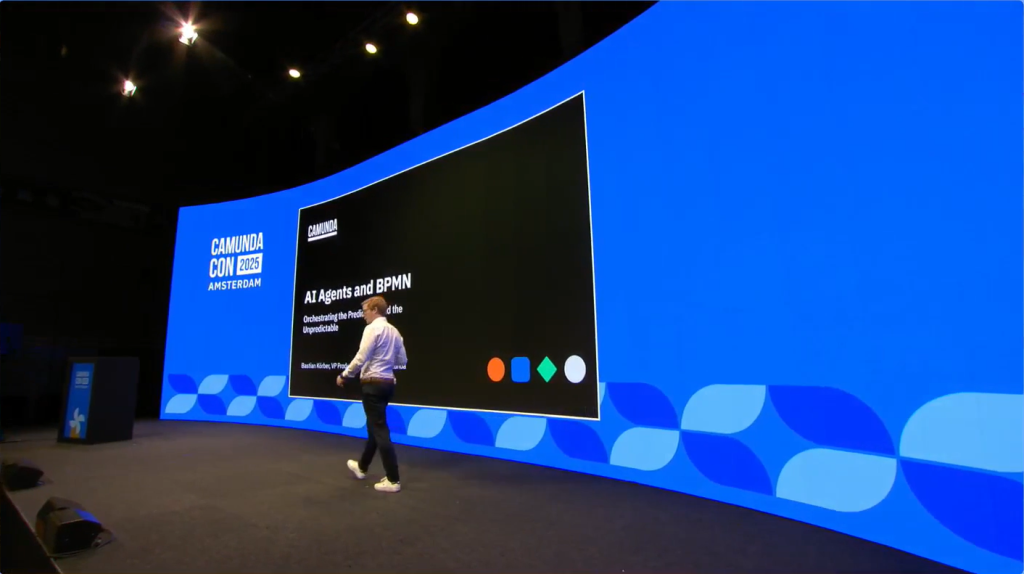
Bastian rejoined us on the stage to dive deeper into how we can use AI Agents and BPMN to generate value today and in the future. Many people are asking whether it’s time to shift to a fully autonomous world, or are we not ready yet and we need to stay in the reliable deterministic world we know? The answer is that it’s not an either/or choice—it’s better together.
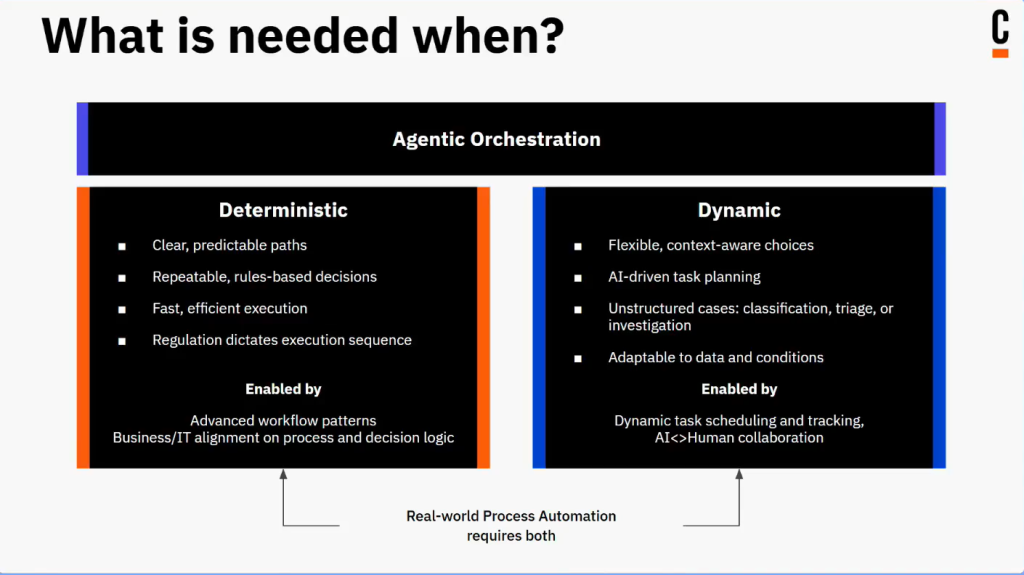
Bastian emphasized that AI Agents thrive in BPMN, not as standalone apps. “We’re not there yet,” Bastian noted. As Bernhard Schaffrik noted earlier, only 1% of core processes will rely on generative AI in 2025. The way to get real-world value today with agentic orchestration is with a blend of deterministic and dynamic orchestration.
Observability is key for building trust and enabling AI to be involved in important processes today. In Operate, Camunda already provides an end-to-end trace tree and zero-downtime fixes, and through Optimize, you can build dashboards to help you understand your costs and bottlenecks. With BPMN and Camunda, you can trust that you know what your AI Agents have been doing, which is not only critical for audits and compliance but also for training and improving.
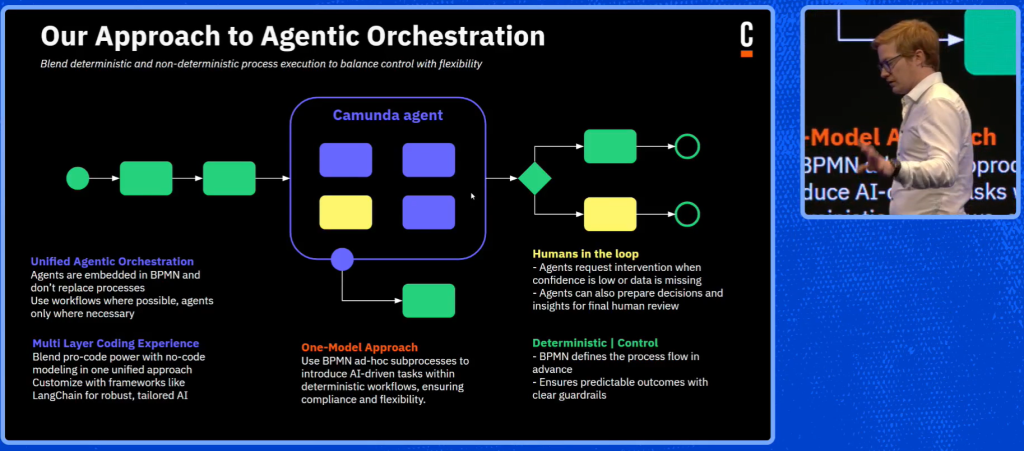
Bastian spoke about new connectors that Camunda recently debuted that enable AI Agents to operate and have a long-term memory, and you can explore these today, but he cautioned that AI is not magic. Think first, code later. Design thoughtfully, including with a “guardrail sandwich” that surrounds an agent with a deterministic task on one side and deterministic validation on the other. There were many other key points here, all great things to think about. Check them out and hear the Q&A in the full presentation.
ICYMI
- Climbing the Mountain: How LBBW is Achieving Digital Transformation via Enterprise Process Orchestration, Benjamin Fürnrohr, Senior Consultant at Novatec Consulting (now part of CGI) and Nils Kaufmann, Head of Process Automation at LBBW led this session about how LBBW (Germany’s sixth-largest bank) began its journey towards Enterprise Process Orchestration along with Novatec Consulting. Gain insights into LBBW’s journey toward Digital Transformation and see how Camunda 8 will play a key role in the company’s plans going forward.
Clearstream: Orchestrating D7 Digital Securities Services supported by Camunda
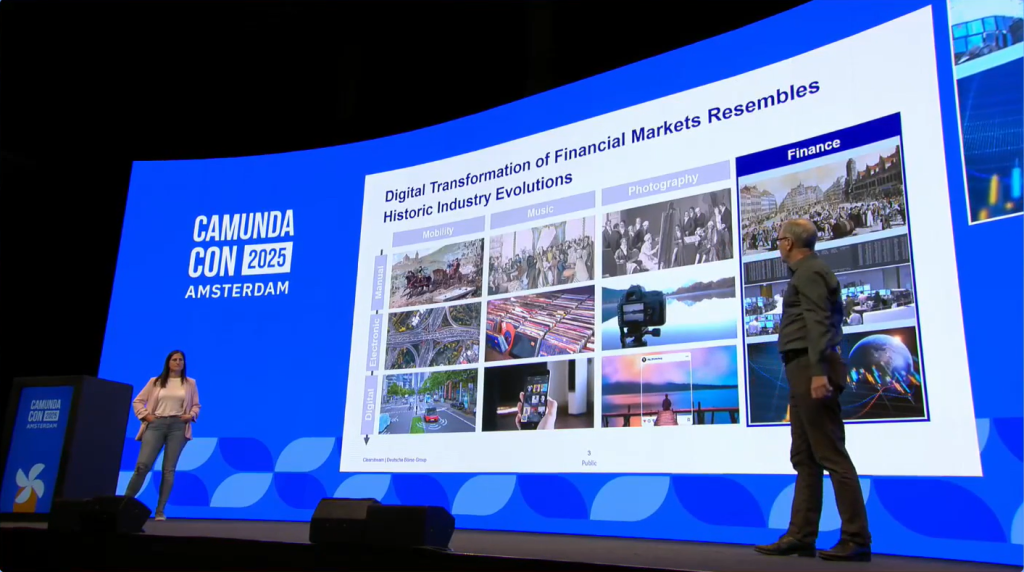
Next up, Julia Blankenberg, Head of Cloud Office, Tools & Orchestration at at Clearstream, and Jürgen Witzel, Project Manager at Deutsche Börse AG joined us to talk the next step in the digital transformation of the Germany-based trading marketplace. Witzel spoke about how the progress for the exchange is much like that in other industries, moving from in-person only to becoming increasingly digitally accessible.
D7 is an improved way for Deutsche Börse AG to offer institutional-grade market digital and tokenized securities insurance. Clearstream processes over 1 million transactions daily with funds from 55 countries. These are large, high volume, global and highly regulated areas—the complexity involved goes without saying. Digital issuance of securities on using D7 is growing rapidly and scalability and security are critical.
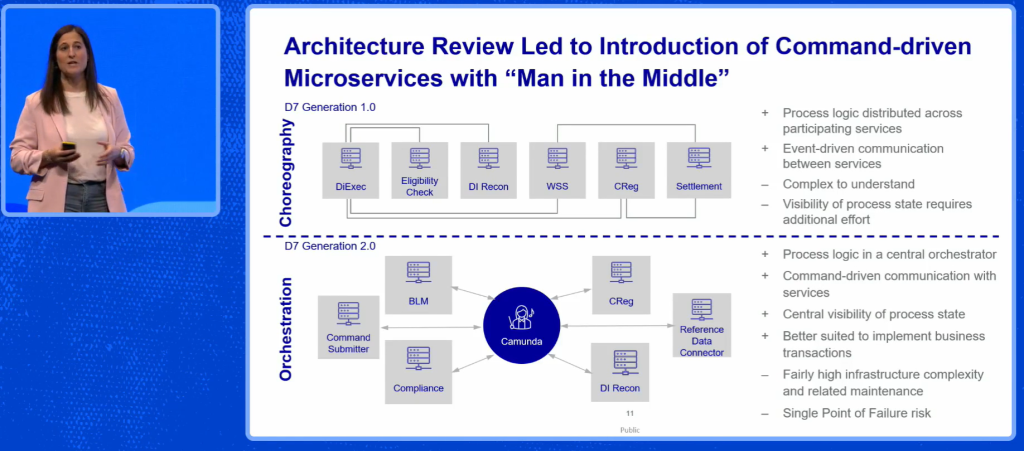
Blankenberg then spoke to more of the technical details, describing their decision to change over time from a choreography-based approach to a microservices orchestration approach with Camunda at the center. This gave them end-to-end process visibility, as well as improving the ability to monitor SLAs, discover issues, improve customer service and have a faster time to market. Witzel emphasized that they also now use Camunda Modeler to model all D7 processes end-to-end, including legacy interactions, which is a huge added benefit.
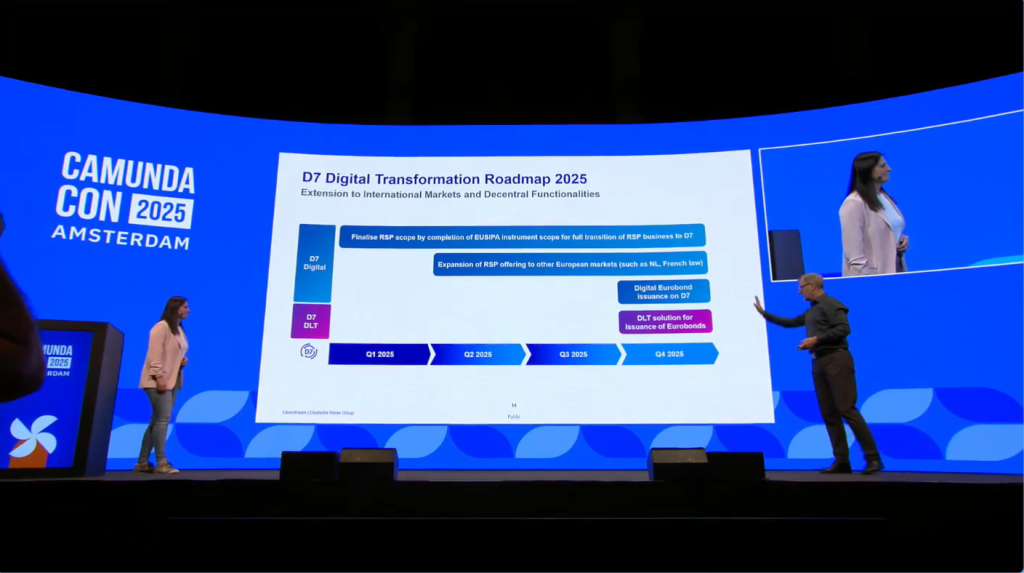
The roadmap for future improvements includes expanding to other European markets, incorporating blockchain transactions (the DLT solution pictured above), and more. Check out this full talk to learn more about how Camunda 8 has played a critical role in helping this financial services organization grow and provide better service to their customers.
ICYMI
- How British Telecom’s next-generation broadcast network relies on Camunda – Ajit Dani, Principal Solutions Architect and Shunxiang Yao, Senior Software Engineer at BT Group talk about the development of Vena, BT’s next-generation service delivery platform for broadcast video distribution in the UK. Vena was created to provide best-in-class performance for media traffic, and to empower customers to self-serve. See why British Telecom relies on Camunda to power Vena, and dive into the benefits of process orchestration and automation for the organization and its customers.
Business Breaks
Next up for our in-person guests, we have our silent disco-style Business Breaks: Powering the digital factory: How Camunda 8 supports Sonepar through checkout process orchestration with Mohamed Elhabib, Solution Architect at Publicus Sapient and Samrawit Yoseph, Director – Product Owner Lead at Sonepar, and Supercharging process discovery with AI-powered landscapes with Eric Lundberg, Senior Product Manager at Camunda.
For our online readers, this is a good chance to stretch your legs. We’ll see you back here shortly!
Transforming digital banking processes with orchestration and automation using Camunda 8

Yuvraj Keenoo, Tech Lead and Bholanathsingh Surajbali, Engineering Lead at MCB (Mauritius Commercial Bank) took the stage next. MCB is a multi-national bank operating in 10 countries with over a million customers. Keenoo started by asking what it would look like if every interaction was automated but also every decision was made in real time? How would that make you feel? Little by little, he said, we are getting there and working towards that.
What was holding MCP back from that today? Surajbali and Keenoo noted several issues: lots of siloed processes with no visibility, time consuming identity verification, disconnected systems with lots of manual work and compliance challenges. To lay the foundation for change, they focused on customer experience. Goals included improving turnaround times, the need to be digital and scalable and omnichannel, as well as compliance and risk reduction. They set business goals of providing 24×7 self-service options, quicker response times and scalability.
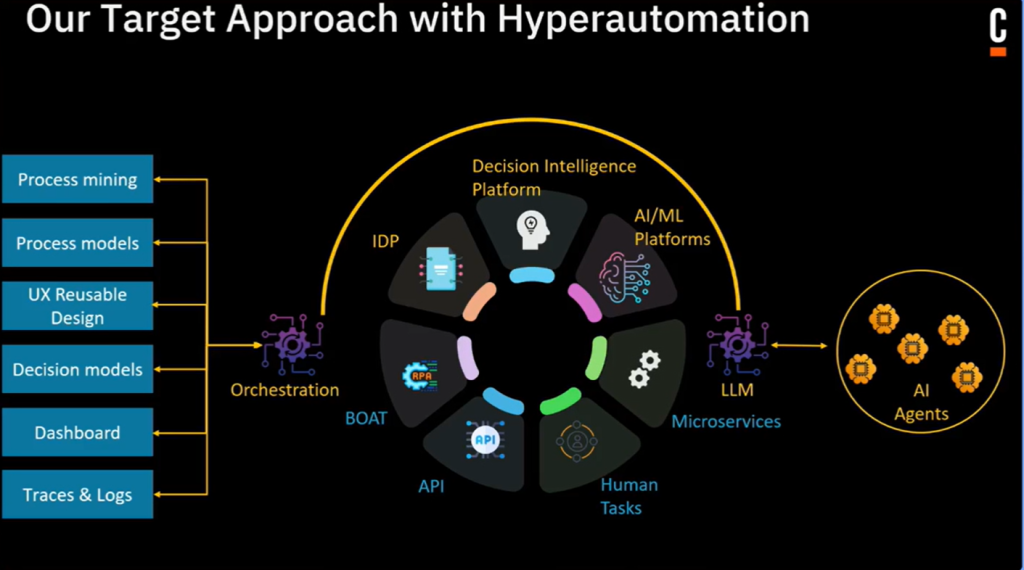
Keenoo laid out their goals with hyperautomation, with an orchestration layer connecting numerous critical tasks throughout the system. It’s an excellent vision, but as Surajbali noted, it couldn’t all be done at once. They needed to go step by step.
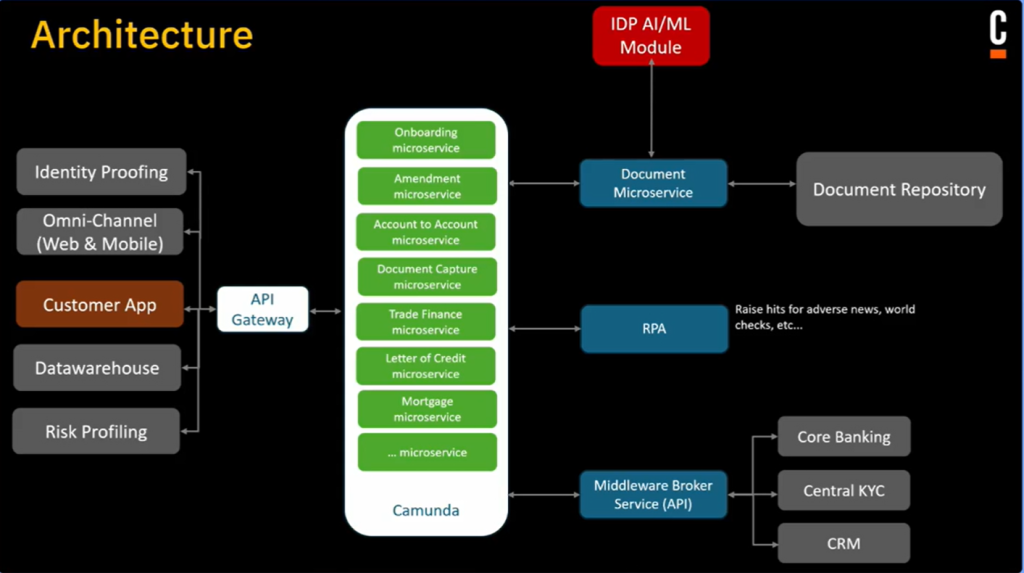
Surajbali went on to explain how a number of microservices, orchestrated by Camunda, can now communicate with APIs, RPA and IDP to greatly enhance a number of key processes. They walked through four use cases in some detail, including onboarding, document classification, faster processing of high-volume documents and account to account transfers.
The results? A huge decrease in onboarding time thanks to IDP (from 70 minutes to 25 minutes), a frictionless digital submission process for users, and a 64% reduction in employee processing time per application. Overall, as they note, “automation is a journey – it’s about constantly evolving and improving.” Their big message to anyone who has not yet embraced automation is to just get started somewhere. Be sure to watch this video to see some innovative examples of automation that are delivering real value in a complex market.
ICYMI
- Empowering Automation: Smarter Orchestration with Camunda – Discover how Camunda’s business orchestration and automation technologies are enhancing task automation. Calvin Robbins, Senior Manager, Product Management and Sahil Bhatoa, Senior Software Engineer – Full Stack at Camunda explore how IDP and RPA integrate seamlessly into Camunda’s platform, driving faster and smarter end-to-end workflows and streamlining automation.
Fireside Chat & Closing
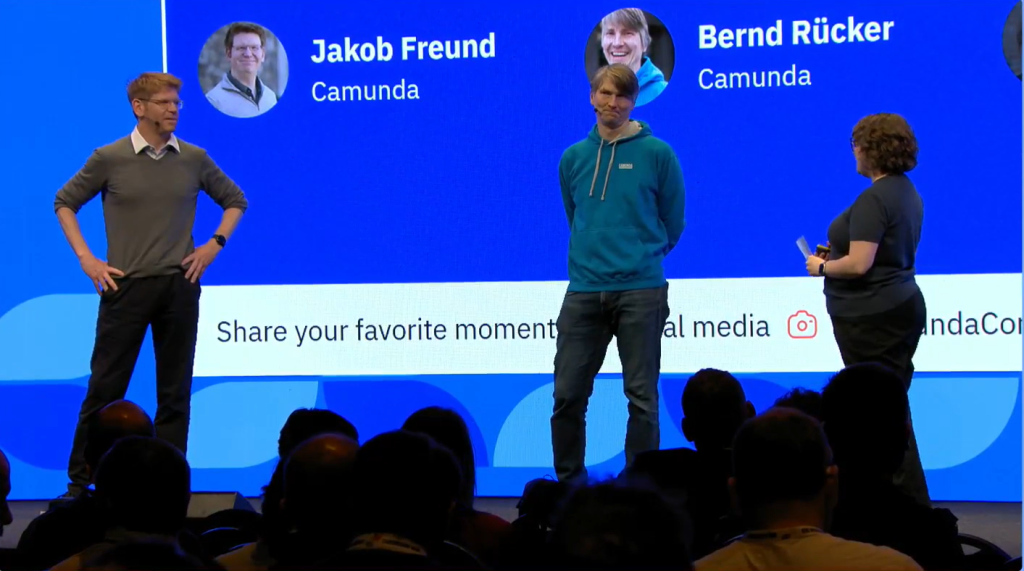
Finally, Amy welcomed Jakob and Bernd to the stage for what will be the final time (how are we already here?). She opened the conversation by asking Jakob about the overall impressions they’ve been hearing about everything Camunda has debuted around agentic orchestration? Jakob said he’s never experienced how much interest he’s seeing right away around agentic orchestration. In the past, it tended to take some education over time but this is really different—the value is obvious. He wasn’t hearing questions about whether companies want it, it’s more about how we can implement it safely and successfully. The feedback on how we’re going about it has always been very positive, particularly the blend of dynamic and deterministic by blending BPMN with ad-hoc sub-process. It just doesn’t exist anywhere else and it’s exciting to hear that from other people.
Amy noted that she was glad organizations were valuing this approach, she wants her bank and healthcare companies to be cautious and not just hand everything to AI. Bernd noted that it reminded him of the early embrace of microservices. Technologies like this aren’t magic solutions to everything, but with the correct orchestration, they can accomplish a tremendous amount.
Bernd reflected that he really enjoyed seeing the developers in the hackday—there were 81 of them!—were building agents in a fun and playful way and seemed to be enjoying the process. He appreciated that people seemed to be understanding not just the why but the how of building AI agents. Amy added that she thought it was so cool that everyone was using a technology that we literally announced two days ago, which is not something that all vendors can say—you can really use what we announce, even the alphas.
Jakob also highlighted that the embrace of recently released features such as IDP and RPA has also been excitingly strong, with dozens of companies already deploying them to production only a few weeks after they became GA in April. Since Camunda typically orchestrates mission-critical processes there is often a slower adoption period, but the backbone of orchestration seems to be helping companies incorporate some of these new additions faster than ever before. The momentum is incredible.
As for final takeaways, Bernd recommended people check out the blueprints and just get started and play around to see how the new additions can help you. He also summed up CamundaCon in two words: Energy and enthusaism. Jakob was excited to see the adoption by both business and IT and thanked everyone for attending and also all Camundi who helped make today happen.
Thanks for coming!
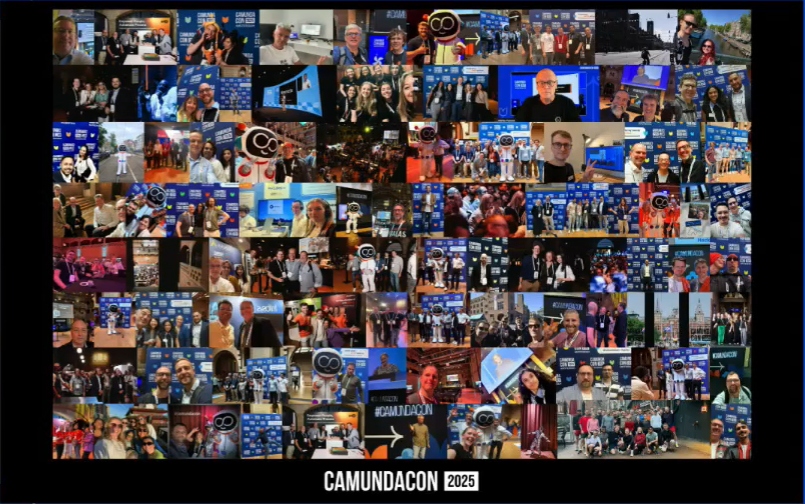
Thank you to everyone who attended and helped make today happen! Your smiling faces in the selfie wall are a sight to behold (and don’t worry, there’s still time to tag your #camundacon #selfie photos!). For anyone who couldn’t join or who missed a session they wish they could have attended, be on the lookout for the video recordings of the talks to come out next week.
See you next time in New York!
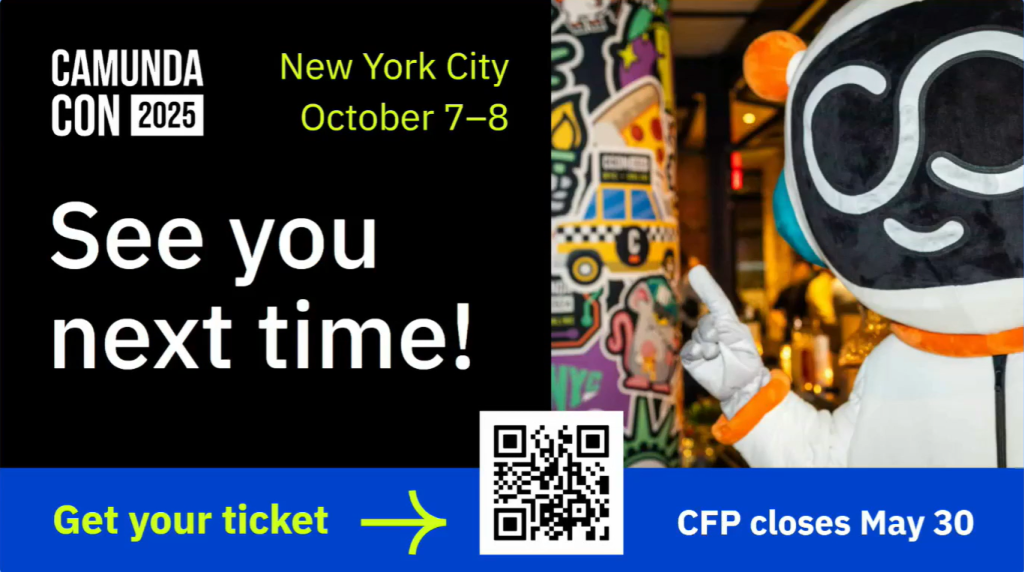
That’s it for CamundaCon 2025 Amsterdam! CamundaCon returns on October 7th and 8th in New York City! Don’t forget to register now, and we’ll see you there!
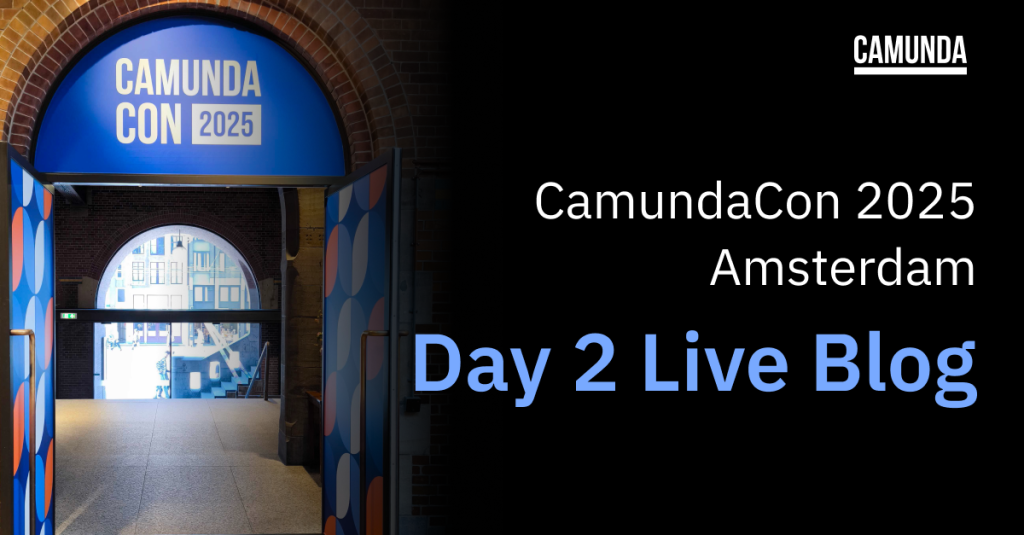


Start the discussion at forum.camunda.io